As a preparation for my thesis project I had to get an overview of the current adventures games. So I bought a couple of popular titles, installed them all and played each game for a couple of minutes first to get and idea what it is about. At that time, one particular game stood out of the crowd – Secret Files: Tunguska. It is a German game by the studio Animation Arts and I heard frequently that this particular Title sets the standards as far as modern adventure games go. Even though I was prepared for a treat, I was still quite impressed by the game’s quality and amount of polish evident from the very first minute on.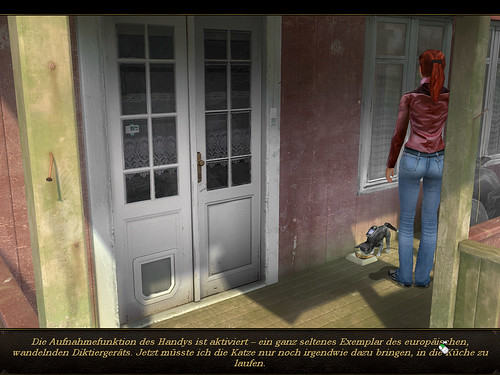
Point & Click Adventures in the Year 2008: Use iPhone with duct tape with cat. (oops, I hope I didn’t spoil this one)
I’ve finished the game and although the quality remains high even up to the end, Tunguska is a good example that polish is a tricky thing.
Again and again, you hear that polish is crucial if you want to make a good game. However, there are at least two myths associated with it which seem to contradict each other. The first one is “You can’t polish a turd”. This means that a game without a worthwhile underlying idea won’t be improved by polishing it. The second myth is that often, it is more valuable to use an already established idea and polish it really good instead of re-inventing the wheel every time. So should you try being innovative or should you rather polish old ideas?
As a matter of fact, although they seem like a contradiction, both myths are true. The apparent contradiction exist only because as most rules of thumb, the two myths make too broad statements to be of any use in a specific scenario. Tunguska falls exactly in the gray area in-between the two and is therefore an excellent object of study to add more detail to the discussion.
Tunguska is a traditional adventure game. You see a character on a mostly static background and you can issue commands by clicking on various hot-spots in the environment. Those tasks mostly involve picking up objects and using them elsewhere in a MacGyver-esque fashion. You can’t really die but the various puzzles do offer a challenge.
As a modern adventure game, Tunguska uses what is often called 2.5D – an expression so overused in different contexts that it actually lost all its meaning. What is meant by that is that the backgrounds are mostly pre-rendered while the characters and other movable objects are displayed with a real-time 3D engine.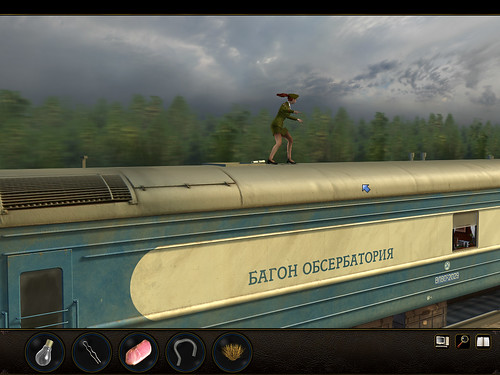
Tunguska uses some nice “2.5D” Effects. In this scene, the character, the treeline and the sky are all animated in real-time 3D. The Train itself is pre-rendered.
So when I speak about polish, I refer to the sheer quality of the pre-rendered graphics. They are very detailed and colorful. They were obviously done by people, who spend a lot of time in their profession and had plenty of time to work them out. They even manage to capture a distinct German look and feel by including typical details like the yellow telephone booths, the construction site markings or that rusty East-European aura of east Berlin. Lots of the backgrounds have also tiny animated details which make everything look less static – a common problem with adventure games.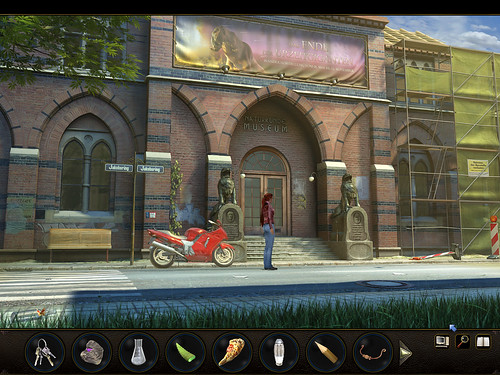
Tunguska features some tasteful pre-rendered backgrounds. On this one, they even managed to include some typical German construction road markings. Also note the street sign which is typical for Berlin.
The sound is top-quality as well. The voices were made by very talented speakers. They never sound out of place, fit well to the characters and are spoken with the correct intonation. The dialogue is brief and sometimes slightly witty. It doesn’t get on your nerves like in some adventure games.
A good indicator for polish are the sound effects because this is where quite often, the first budget savings are made (or where budget is under-estimated in the first place). There are lots of situations where a whole atmosphere is created simply by the sounds. In one particular scene you are standing on a road in a sub-urban area and although you can’t see on the street, you hear a single car dive by every now and then. It is a clean, good effect and well-timed so it doesn’t feel repetitive. Yet, it vastly contributes to scene by making it appear more dynamic and underlining its sub-urban character.
Three examples of polish in Tunguska. The yellow telephone booth and the windmills have a German feel (even though the pickup truck and the architecture don’t). From time to time, you hear a single car driving by with loud techno music running. Also, note how the mouse cursor (over the red bike) indicates how the verbs are mapped onto buttons.
But it is not only about the content, the menus are also very polished. There are small animations indicating when items leave or enter your inventory. Some icons are “pulsating” in size so they look less static and it is more clear that you can interact with them.
And the controls are polished too. There is a function Tunguska is famous for they call “Snoop Key”. By pressing the space bar, you can highlight all the hotspots in the environment so you don’t have to pixel-hunt anymore. Some previous adventure games already had that kind of function (Simon the Sorcerer 2 for example) but somehow Tunguska is always being praised for it. I believe one reason is because they point it out as such an important feature (they even have a small logo for it) and because it feels so integrated into the interface and the gameplay rather than being a gimmicky afterthought.
Snoop Key: Pressing the space bar will highlight all hotspots with neat, animated icons. Extremely useful, yet totally optional for the hardcore-pixelhunt crowd.
Also, all the verbs in the game have been reduced to just two which were mapped on the two mouse buttons, eliminating the need for any on-screen verb interfaces. The functions of the mouse buttons are constantly visualized by a context-sensitive mouse cursor which tells you what mouse button does what in each case.
The puzzles are well thought-out. There is rarely a situation where you get totally stuck. This was achieved by cutting the game into very small parts. So when you have a puzzle to solve, there are always just a few screens you can access to. You don’t waste your time searching for the answer in the wrong places. This doesn’t mean that the solutions are straight-forward by the way. There is a particular “use duct tape with iPhone and cat”-puzzle I found engaging and quite funny.
Finally,I discussed the theme and marketing side of Tunguska with my colleague Daniel Renkel. The whole game is obviously trying to imitate the X-Files. The characters are Scully and Mulder look-alikes, the story evolves around the Tunguska incident which is often associated with UFOs. Even the name says it all “Secret Files: Tunguska”. Unlike Daniel, I do believe that this is a valid strategy, especially if you are selling an adventure game. You won’t get enough exposure in game magazines. They won’t take you seriously. You don’t want to address young gamers anyway. Your target groups are actually people, who played computer games in the 90ies. So the X-Files is a good choice and the imitation well-executed. The similarity is obvious. From the perspective of a customer, you get a pretty good idea what the game is about if you see it the first time in the shop – a topic I wrote some time ago on Game Design Scrapbook.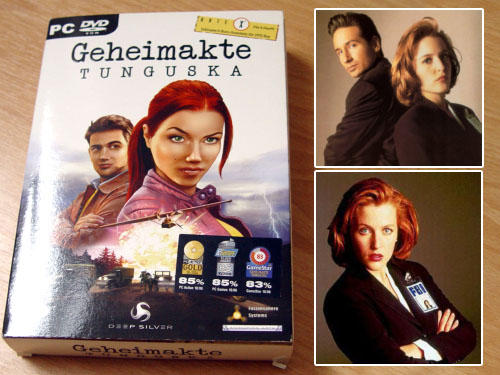
Tunguska Inspired by The X-Files? The 5€ coupon for The X-Files DVD included in Tunguska might be also a hint.
By the way, Tunguska actually has another inspiration besides X-Files which is Indiana Jones. It is hinted by the airplane stunt on the cover and by the Indiana Jones-esque world map when you open the flap on the package. It becomes more evident in the story.
So with so many details, good ideas and polish – where did they go wrong?
Well, to cut to the chase, it’s a variation of the Fahrenheit Syndrome (aka Indigo Prophecy Syndrome). The beginning is all good and well and feels like X-Files. You have to investigate the kidnapping of your father. Everything is serious and realistic. The first hint of things going haywire is when one of the characters announces he has a private seaplane at the airport they can use to fly over to Russia. Right. A private seaplane. Well, that’s the Indiana Jones thing kicking in and although quite unrealistic and wacky you could overlook that. Unfortunately, it spins out of control by the end where one character (”Scully”) is on the south pole and have to stop a random mad man from using alien technology to deploy a device for mind-controlling the WHOLE WORLD “And take it ransom for one million dollars *evil laughter*” or something – I didn’t care at that point. Meanwhile, the other character (”Mulder”) teams up with an ancient religious cult (who are actually aliens) to come to the rescue in a Lockheed C-130 he seems to have pulled right of his ass.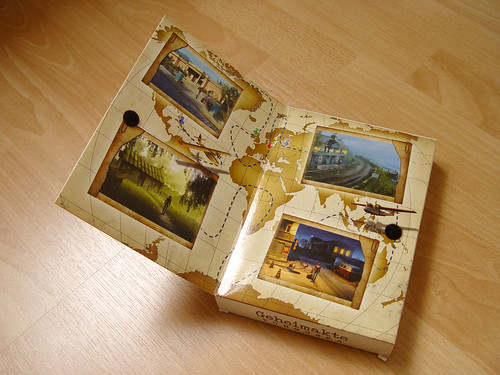
The packaging is extremely well done. It is printed on glossy, embossed cardboard with a bunch of Screenshots behind an additional flap. The theme changes from X-Files to Indiana Jones, though. What it means in-game is that almost every character not only has a pilot’s license, they also turn out to own a plane at the most convenient moment.
I already wrote about a few adventure games (Experience 112, The Longest Journey) suffering from Fahrenheit Syndrome but each one of them had at least one new, innovative idea. Also, because of their experimental nature, there weren’t quite polished otherwise so the bad ending was just one of many shortcomings.
The ending in Tunguska feels like a betrayal. All the polish and everything seem so nice and well thought-out. You are left wondering why they went all those lengths just to serve you all that crap in the end.
Let’s come back to the two myths I spoke about earlier. Tunguska seem to have taken the “polish an established idea” strategy by carefully selecting popular themes (X-Files, Indiana Jones) using a simple and established genre. Unfortunately, it works well until the very end where the “you can’t polish a turd”-rule kicks in. By systematically copying established ideas, you build a house of cards that falls apart if you can’t add some good ideas of your own to rationalize the project. This rationalization is needed by the player to feel like the time spent on the game actually leads towards something worthwhile. If the rationalization is missing, the project becomes an elaborate but hollow scheme to make money and nothing else.
In Tunguska, the whole point of the game is in fact simply missing. The developers couldn’t copy that. By polishing everything else so well, they made that fact even more obvious, raising expectations among players. They were even unfortunate enough to pick the adventure game genre where that particular problem is especially severe. Adventure games are not re-playable and do not teach any skills so all the player takes from the game when is over is the story and especially its conclusion.
So we are left with an example of great game development but a case of crappy game design.
It could be worse, I guess. From the developer’s standpoint, I do value Tunguska for its polish and production values. It is also somewhat valuable because it inspired some technical developments in the adventure games genre, like the now obligatory Snoop Key. It also raised the bar as far as quality goes. There was a recent Nintendo DS and Wii remake which you might want to try out because of that. There is also a sequel which I expect to suffer from similar problems. In the end, I suspect that many people will never notice the game’s pointlessness because they might give up at some of the more difficult puzzles – they are the lucky ones.
Here is my attempt at clearing the contradiction between the myths about polish. Taking established ideas and polishing them works well as long as you don’t loose the big picture. You need to consider what kind of value the players will take from your project. What kind of “right” does your game have to exist in the first place. Polish itself delivers no value.
The interesting thing is that there is a different German adventure game which took a strategy opposite to Tunguska and it didn’t work out well either. I will discuss it in a future article.






Thanks for the analysis of Tunguska, but I think your central idea — that there is a contradiction or apparent contradiction between “you can’t polish a turd” and “polishing an established idea is good” — is just wrong. You seem to be assuming that an established idea is the same as a turd, which is silly: usually (admittedly not always) an established game design idea is established because it is a good idea!
I’m not saying that innovation isn’t nice, but it certainly isn’t necessary to avoid turdhood.
You are right, this is somewhat a strawman argument.
But I still think the two myths overlap at least to some extent. The “Turd” one is just so hyperbolic. “Turd” in this means a “bad” idea. This can mean old, boring, over-used or even cliché. Fixing that with just polish might not be enough as in case of Tunguska.
Or to put it differently: The flipside of “established” is that you have larger footsteps to fill.
humm, haven’t play the game so I may be wrong, but it looks like the problem is basically that the story suck … a problem common to a LOT of games
Story Sucks – I guess you could boil to this. But there is more: In some games, a bad story is acceptable if there are other redeeming factors: innovative game ideas, unique themes, interface innovations, Lebensrelevanz (more on that later) etc.. Experience 112 or Fahrenheit are good examples. If none of that is present all you left with is just the bad story.
And it’s not just that the plot is cheesy and unconvincing. It also has no meaning beyond the superficial action. There is even no character development.
agreed
“The flipside of “established” is that you have larger footsteps to fill.” That’s a good point, and it’s something that producers looking for a surefire hit seem to forget. Yes, a copycat knows that a market exists, but why should anyone play Game B if it’s the same as Game A but worse?
OTOH, the games that make the large footsteps aren’t the ones to first introduce a new idea (Dune II), but the first to show off an idea in polished form (Warcraft II). This, I think, is the core of successful game publishing: let others generate ideas. Some will be turds, others will be established (but not yet done-to-death) ideas. Steal and polish the latter. Profit!
About your Dune II vs. Warcraft example – actually there were a lot of differences between Warcraft and Dune II. The polished version of Dune II was rather Command & Conquer.
Things get more difficult when we talk about action and strategy games. For example – both are re-playable which means they offer value even if you already saw the content once. So bringing out another game with more of the same gameplay is less problematic. This less true for adventure games.
Yesss! You are absolutely right. A computer game is not just programming technique. It is story and design. For me design means that one can say “Oh how beautiful” or “Wow, impressing environment”. You can find that in Syberia 1 and 2, in the late Myst 5, 5 and Uru.
All these games are story-driven. You are not just looking for stupid stones and nails to put them together to a tank-tool, even if you have no idea what this tool could be used for.
And then, these never ending “dialogues” drive me crazy. One problem of this game is that the player does not know what he wants and how he could reach his goal (difficult if he has none).
The 3D environment is, well, 3D. It is neither interesting nor beautiful. It is not even functional.
Some guys tried to make a buck, and that is it.
JML
I do appriciate your enthusiasm but I suggest you should re-consider your concept of what “design” is. It’s a lot more that making things “beautiful”. Actually, it doesn’t even have to do anything with “beauty” at all.
http://en.wikipedia.org/wiki/Design
To quote from Wikipedia, “no generally-accepted definition of design exists”. You idea of design is apparently to make things interesting and innovative, or to add “Lebensrelevanz”. I propose the “professional touch” as an over-arching concept – to have the game look like it was meant the way it turned out.
I propose the “professional touch” as an over-arching concept – to have the game look like it was meant the way it turned out.
I mostly agree with your review of “Tunguska”, but the back of the package should be warning enough not to expect anything too serious or revelant. It is one among many riding the supernatural mega-wave, and pleasantly free of set-piece demons. The story is totally forgettable, and the interface “improvements” have been over-hyped because they’re really everything that’s outstanding about this game. Not really worth a review unless hype bothers you, or because the game is German.